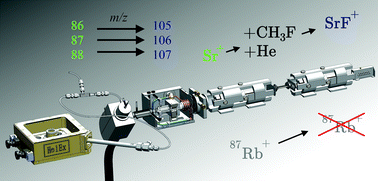Laser ablation-tandem ICP-mass spectrometry (LA-ICP-MS/MS) for direct Sr isotopic analysis of solid samples with high Rb/Sr ratios
Abstract
The combination of laser ablation and tandem ICP-mass spectrometry (LA-ICP-MS/MS) allows for successful Sr isotopic analysis of solid samples with high Rb/Sr ratios. Isobaric overlap at a mass-to-charge ratio of 87 (87Sr–87Rb) is overcome via chemical resolution. By using CH3F/He (10% CH3F in He), in an octopole collision-reaction cell, Sr+ ions are converted into the corresponding SrF+ reaction product ions, while Rb+ ions show no reactivity towards this gas mixture. Two sample introduction setups, leading to “dry” and “wet” plasma conditions, respectively, were evaluated and the figures of merit are documented in detail. The 87Sr/86Sr isotope ratio results were corrected for instrumental mass discrimination using a double correction approach – internal correction using the Russell law, followed by external correction in a sample–standard bracketing (SSB) approach. NIST SRM 610 was applied as an external standard for mass bias correction; no closer matrix-matching was required for the sample types investigated. Under “wet” plasma conditions, accurate and precise (0.02–0.05% RSD) 87Sr/86Sr isotope ratio results were obtained for 7 glass-type geological reference materials.



 Please wait while we load your content...
Please wait while we load your content...